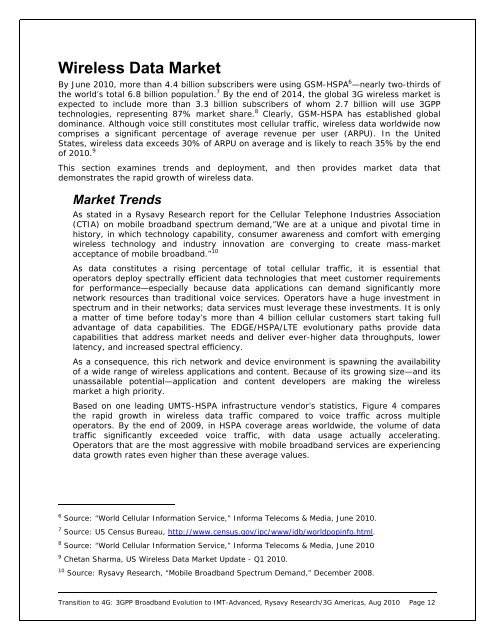3GPP Broadband Evolution to IMT-Advanced - 4G Americas
3GPP Broadband Evolution to IMT-Advanced - 4G Americas
3GPP Broadband Evolution to IMT-Advanced - 4G Americas
- No tags were found...
Create successful ePaper yourself
Turn your PDF publications into a flip-book with our unique Google optimized e-Paper software.
Wireless Data MarketBy June 2010, more than 4.4 billion subscribers were using GSM-HSPA 6 —nearly two-thirds ofthe world’s <strong>to</strong>tal 6.8 billion population. 7 By the end of 2014, the global 3G wireless market isexpected <strong>to</strong> include more than 3.3 billion subscribers of whom 2.7 billion will use <strong>3GPP</strong>technologies, representing 87% market share. 8 Clearly, GSM-HSPA has established globaldominance. Although voice still constitutes most cellular traffic, wireless data worldwide nowcomprises a significant percentage of average revenue per user (ARPU). In the UnitedStates, wireless data exceeds 30% of ARPU on average and is likely <strong>to</strong> reach 35% by the endof 2010. 9This section examines trends and deployment, and then provides market data thatdemonstrates the rapid growth of wireless data.Market TrendsAs stated in a Rysavy Research report for the Cellular Telephone Industries Association(CTIA) on mobile broadband spectrum demand,”We are at a unique and pivotal time inhis<strong>to</strong>ry, in which technology capability, consumer awareness and comfort with emergingwireless technology and industry innovation are converging <strong>to</strong> create mass-marketacceptance of mobile broadband.” 10As data constitutes a rising percentage of <strong>to</strong>tal cellular traffic, it is essential tha<strong>to</strong>pera<strong>to</strong>rs deploy spectrally efficient data technologies that meet cus<strong>to</strong>mer requirementsfor performance—especially because data applications can demand significantly morenetwork resources than traditional voice services. Opera<strong>to</strong>rs have a huge investment inspectrum and in their networks; data services must leverage these investments. It is onlya matter of time before <strong>to</strong>day’s more than 4 billion cellular cus<strong>to</strong>mers start taking fulladvantage of data capabilities. The EDGE/HSPA/LTE evolutionary paths provide datacapabilities that address market needs and deliver ever-higher data throughputs, lowerlatency, and increased spectral efficiency.As a consequence, this rich network and device environment is spawning the availabilityof a wide range of wireless applications and content. Because of its growing size—and itsunassailable potential—application and content developers are making the wirelessmarket a high priority.Based on one leading UMTS-HSPA infrastructure vendor’s statistics, Figure 4 comparesthe rapid growth in wireless data traffic compared <strong>to</strong> voice traffic across multipleopera<strong>to</strong>rs. By the end of 2009, in HSPA coverage areas worldwide, the volume of datatraffic significantly exceeded voice traffic, with data usage actually accelerating.Opera<strong>to</strong>rs that are the most aggressive with mobile broadband services are experiencingdata growth rates even higher than these average values.6 Source: “World Cellular Information Service,” Informa Telecoms & Media, June 2010.7 Source: US Census Bureau, http://www.census.gov/ipc/www/idb/worldpopinfo.html.8 Source: “World Cellular Information Service,” Informa Telecoms & Media, June 20109 Chetan Sharma, US Wireless Data Market Update - Q1 2010.10 Source: Rysavy Research, “Mobile <strong>Broadband</strong> Spectrum Demand,” December 2008.Transition <strong>to</strong> <strong>4G</strong>: <strong>3GPP</strong> <strong>Broadband</strong> <strong>Evolution</strong> <strong>to</strong> <strong>IMT</strong>-<strong>Advanced</strong>, Rysavy Research/3G <strong>Americas</strong>, Aug 2010 Page 12
















